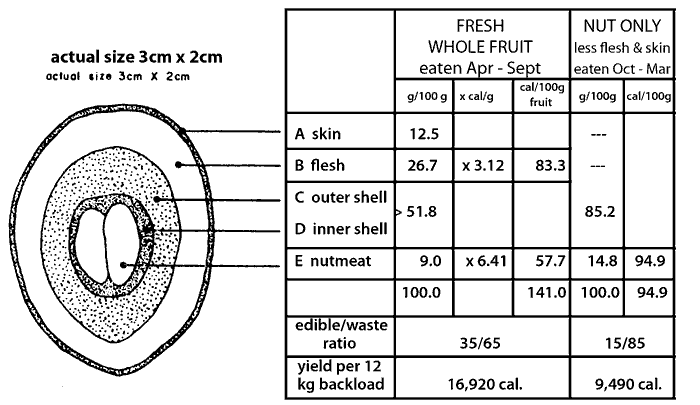
FRUIT FOR THOUGHT
MONGONGO ET AL.
MONGONGO
The Mongongo nut of South West Africa is indeed a fruit of great promise. (In reference to a request for more information from D.J. Hunter of Moranbah, Qld.)
THE MONGONGO - Ricinodendron rautanenii Schinz - is not only a nut, but has an edible fruit as well. The fleshy mesocarp is green to red and dry and tastes somewhat like a date. It dries well and can be eaten for six to eight months after it has fallen.
The nut is similar in appearance and size to a hazelnut and when roasted tastes like cashews or almonds.

The mongongo tree is in the Euphorbiaceae family, and it grows 8-12m in height. It comes from a dry region of 350-700mm of rain and seems best suited at elevations of 1000-1500m. It does not tolerate heavy soils and thrives on sandy ridges.
It appears that female and male flowers are borne on separate trees and yields of 950 nuts per tree have been estimated in the wild.
Much of the above information was taken from an excellent article by R.B. Lee entitled:
"MONGONGO: THE ETHNOGRAPHY OF A MAJOR WILD FOOD RESOURCE"
Ecology of Food and Nutrition 1973, Vol 2, pp.307-321
MAPRANGS AND KADIS
Dr.Glowinski from Caulfield, Vic. seeks information on these two wonderful fruit.
The 'Wan' maprang (Bouea macrophylla) is in Queensland. The first imports of selected clones came in late in the 1970s from Thailand and were called 'Wan Keow'.
Later a plant from Bill Whitman's tree in Florida was imported. This was renamed 'Wan Keow' during its internment in Plant Quarantine. It will be interesting to see if these two introductions are in fact the same variety.
Maprangs, sometimes called 'Gandaria' and 'Kundung' come in sweet and sour forms and grow into large beautiful trees with new purple foliage.
GARCINIA BARRETTIANA is not really a native American Garcinia. It was introduced into Honduras from the Philippines.
O. W. Barrett - in his book The Tropical Crops of 1928, mentions "The Kadis, G. barrettiana, is endemic in the great Cotabo Valley of Mindinao where it forms a tree 15 to 20 feet high. The fruit is of an unusual colour, light orange, juicy, subacid and of a good flavour; the fleshy pericarp also is edible. This is one of the most promising of the new garcinias."
Recently I had a friend who spent nine months in Mindinao and he made numerous trips to the Cotabo Valley - specifically to search for this fruit. He could not find one. The area has been repeatedly savaged by typhoons and has been extensively cleared for pineapples.
Barrett also mentions many other promising garcinias.
| Those of an agreeable flavour: | |
| G. laterifolia | G. cumingiana |
| G. mooreana | G. dioica |
| G. benthami | G. delpyana |
| G. cornea | G. globulosa |
| G. cowa | G. fusca |
| G. prainiana | G. paniculata |
| G. lancaefolia | |
| Those dried or dried and salted and used in cooking: | |
| G. atroviridis | G. pedunculata |
| G. cambogia | G. planchoni |
| G. loureiri | G. oliveri |
As a footnote Barrett includes one garcinia from Australia - G. mestooni. "The roundish fruit, two by three inches, is smooth, green. fleshy and of a pleasantly acid flavor".
DATE: November 1985
* * * * * * * * * * * * *
